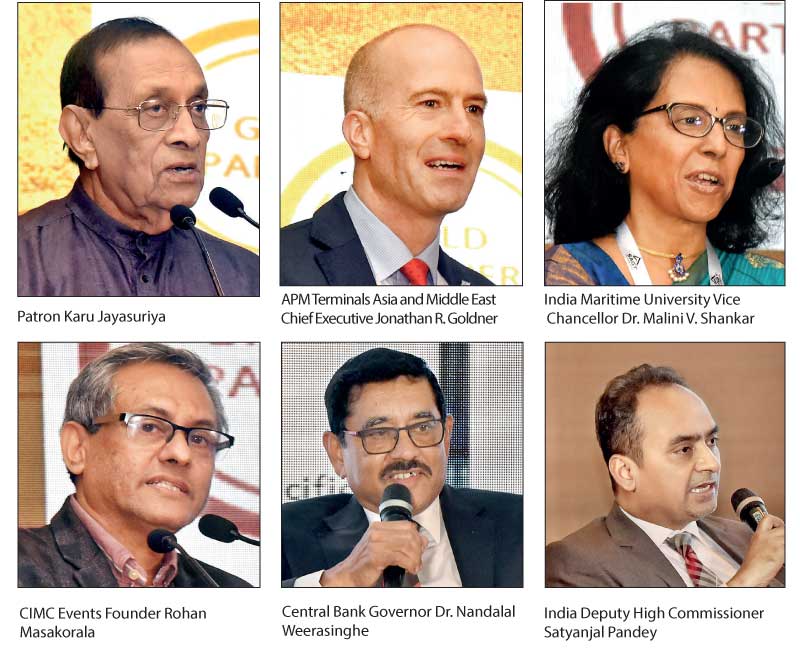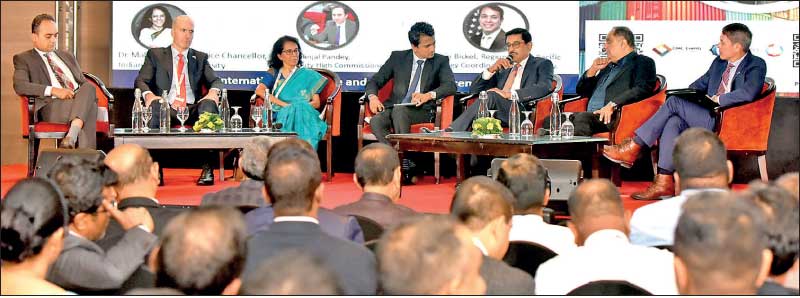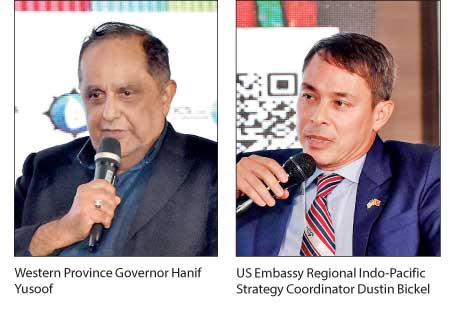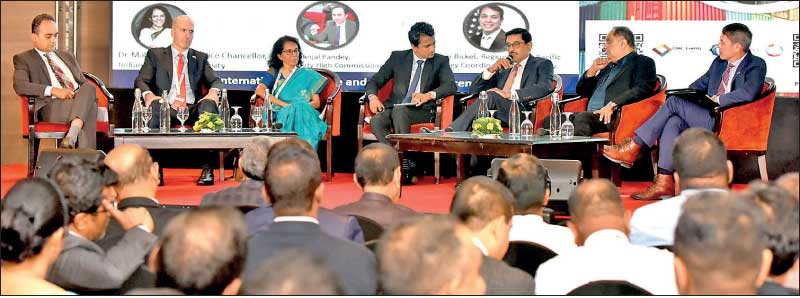Sunday Apr 20, 2025
Sunday Apr 20, 2025
Monday, 2 December 2024 02:11 - - {{hitsCtrl.values.hits}}


 By Divya Thotawatte
By Divya Thotawatte
With the right strategies and moves, Sri Lanka is well on its way to becoming a maritime hub, revealed experts at the recent inauguration of the Colombo International Maritime and Logistics Conference (CIMC) 2024.
CIMC 2024 is the seventh edition of the Maritime and Logistics Conference, held on a rotational basis in South Asia among maritime nations. The conference focuses on discussing the regional developments of the shipping, ports, and logistics industry, which is a significant contributor for the economic development of South Asian countries.
Supported by the Ministry of Transport, Highways, Ports and Civil Aviation and the Ministry of Foreign Affairs, the event was held from 27 to 29 November, with many international speakers and around 500 delegates taking part in this three-day conference. Prominent local and international industry leaders discussed the current state and investment opportunities in the maritime economies, outlining strategies for regional growth while improving Sri Lanka’s position as a global maritime hub.
Sri Lanka’s maritime potential
Speaking at the inauguration, Former Speaker Karu Jayasuriya emphasised Sri Lanka’s potential to emerge as a leading maritime hub in Asia, citing the country’s geographical advantage and opportunities it created within the shipping and logistics sectors. The Government should also recognise the industry as a high potential growth sector and foster an environment conducive to attracting foreign direct investments (FDI), he stressed.
“I also hold the view that Sri Lanka has the potential to become an educational hub and also a medical hub. The Government will need to take pragmatic decisions and appoint independent professionals to make way for right policy decisions to attract much needed investment into Sri Lanka. Since Sri Lanka is in a challenging and daunting economic crisis, the maritime sector can play a vital role to increase foreign exchange earnings as an indirect export through services to global trade. However, the sector needs to properly open up foreign direct investments and expand private public partnerships.”
Reflecting on the country’s historical reliance on its geographical advantages, Western Province Governor Hanif Yusoof, pointed out that while Sri Lanka has rested on its laurels, surrounding nations have surged ahead. “We keep talking about the long years of history that we have in this country. But why is everybody around us going leaps and bounds?”
Expressing his commitment to transforming the region and boosting Sri Lanka’s economy, he emphasised the importance of ambitious plans, particularly in relation to the port and airport, while focusing on infrastructure, efficiency, and safety to attract investment.
“Make it (the Western Province) clean, make it efficient, make it safe for women, and transform in such a way that the people would come and invest,” Yusoof said, highlighting that the province accounts for 44% of the country’s GDP, positioning it as a crucial area for the country’s economic growth.
He added that there were collaborations in progress with the Indian and Chinese embassies to bring expertise from regions like Pune and Gujarat to contribute to Sri Lanka’s $ 45 billion export goal. “If the port and airport are running, we believe that we can come to that,” he said.
Economic growth and stability
Building on these ambitions, Central Bank Governor Nandalal Weerasinghe also emphasised the logistics sector’s critical role in the country’s future, particularly in driving export-oriented growth and stability. He stressed the importance of continuous reforms particularly in logistics, road, energy and digital infrastructure, noting these areas as “where we have the potential of the economy and can benefit the people.”
Reflecting on Sri Lanka’s journey since the 2022 financial crisis, Weerasinghe said that while there were significant challenges, such as sovereign debt, inflation, and fiscal deficits, the country has made progress in stabilising its economy. He said that, compared to the past, he felt more relaxed now, as many critical issues had been addressed including inflation control and building economic buffers.
However, he cautioned against complacency, stressing the need to build resilience against potential shocks, including geopolitical risks, and to ensure Sri Lanka capitalises on its advantages in logistics and export services.
“The next phase of worries is how we can transform this stability into recovery and growth in a sustainable manner,” Weerasinghe added, encouraging stakeholders to implement reforms that will unlock Sri Lanka’s full economic potential.
International collaborations and maritime development
In its journey of establishing Colombo as a global maritime hub, international collaborations, capacity building and research were key, said Indian Maritime University Vice Chancellor Malini Shankar. She highlighted that beyond trade and investment, developing human resources and fostering innovation was crucial for growth.
“To become a true maritime power, it’s not just about seafarer training, but also advancing research and development in logistics, scientific innovation and today’s energy. Norway’s focus on knowledge and research is a model for Sri Lanka to follow. We need collaborations that lead to tangible outcomes in connectivity and development,” Dr. Shankar said.
Emphasising that renewable energy also played a key role in the long-term development of the sector, US Embassy Regional Indo-Pacific Strategy Coordinator Dustin Bickel also stated, “Sustainability is a key element of the ports of the future.”
He detailed initiatives like capacity-building programs for Sri Lanka Ports Authority staff, and sustainability efforts through the Port Greening initiative. These programs focused on renewable energy, electric machinery, and efficiency improvements, all supported by the US Indo-Pacific Strategy to contribute to Sri Lanka’s port infrastructure and maritime development.
Bickel also noted efforts to enhance security by providing radiological detection equipment and law enforcement training, as well as fostering regional connectivity through workshops and collaborations. These initiatives were aimed at strengthening Sri Lanka’s role in the Indo-Pacific region and creating a more connected and resilient port sector, he said.
India Deputy High Commissioner Dr. Satyanjal Pandey explained that Sri Lanka’s strategic location in the Indian Ocean positioned it to greatly benefit from the growing trade in the region. With neighbouring countries like India, Bangladesh, and Myanmar, Sri Lanka was ideally situated to capitalise on the maritime routes that carry 70-80% of global trade. India’s economy was rapidly expanding, with a target of reaching a $ 30 trillion economy by 2047, and 90% of India’s trade relied on maritime routes.
Dr.Pandey stated that Sri Lanka could benefit from this growth by utilising its position to attract business, not only from India, but also from Africa and Southeast Asia. “Frankly, world trade could be at Sri Lanka’s feet, and the Indian possibility of growth is really for Sri Lanka to exploit. A rapidly-developing Sri Lanka is in India’s interest, and likewise, a rapidly-developing India is always in Sri Lanka’s interest.”
Adapting to global trade dynamics
In addition to fostering global partnerships, the maritime sector should also stay agile, adjusting to the changing dynamics of global trade and geopolitics, said experts.
The maritime and logistics industry is evolving rapidly due to shifting geopolitics and technological advancements, said APM Terminals Management Asia and Middle East Chief Executive Jonathan Goldner. He explained that with the global routes that were changing due to geopolitics such as the ‘China plus one’ strategy, Sri Lanka, particularly Colombo Port, would be affected by these shifts.
“Imports will continue to be shock absorbers, as that happens. We’ve seen a great example of that here in Colombo when ships rerouted around Africa and the port stepped up to help absorb that shift in trade.”
However, our ports still needed to adapt to global trends by upskilling their workforce, utilising technology for supply chain planning and preparing for volume surges. Cybersecurity was also a growing concern while improved visibility, predictive maintenance, AI and digital twins were rapidly being used to enhance port efficiency.
Goldner also stated that APM Terminals were focused on resilience and investing in making ports more robust, considering the increasing impact of climate change. With this regard, he highlighted that it was also important to make Sri Lankan ports more resilient to extreme weather.
Pix by Ruwan Walpola
